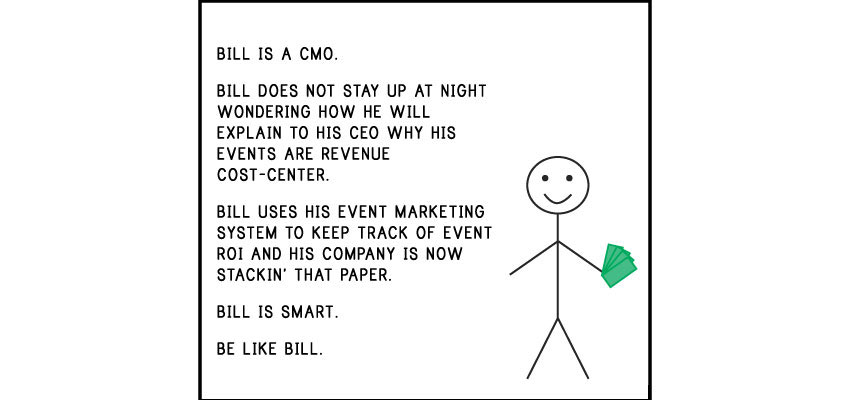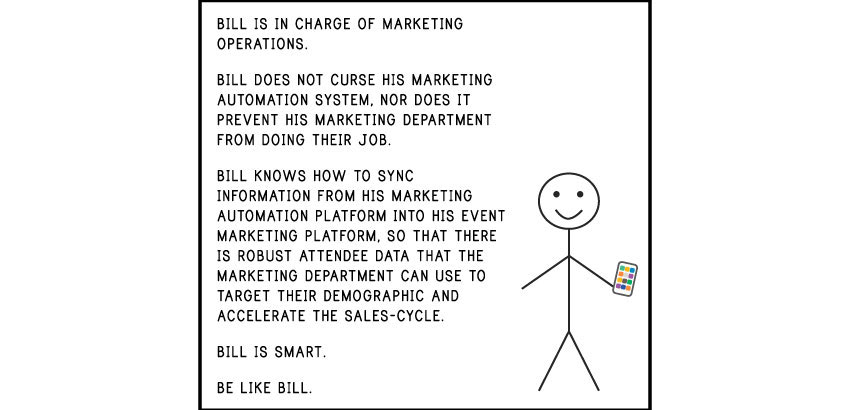Last week, the Be Like Bill meme went viral. If you were too busy putting out event marketing fires to be glued to your Facebook feed, here’s what went down.
Although it’s still unclear exactly who originated the Be Like Bill meme, it was created to humorously poke fun at irritating Facebook behaviors. Some examples include everything from “vaguebooking” to sharing photos of every single meal you ate last week.
Its popularity can only attest to one thing: we’re all suffering from a bit of Facebook fatigue–an apparently incurable condition that only increases in severity with each new irritating post from a friend, a relative, or even that kid you road on the school bus with in the second grade asking you to “like” their 1000th selfie post or status update about the other half pound they lost this week. Here’s an example of one of the many popular Be Like Bill memes: (image courtesy of Facebook OfficialBLB)
Facebook can be an awesome place to engage with your community, and it’s also transforming into a marketing platform that will soon present a serious challenge to LinkedIn and Twitter’s B2B hegemony. But like every other social media platform, it also has its weaknesses . I wrote recently about how Audience has dethroned Content to become king.
And really, when it comes down to it, Facebook’s marketing strength is also its primary weakness: everyone is there. That’s right, we said everyone–your Luddite grandma, your internet stalker, and even your well-intentioned friend who doesn’t know the meaning of TMI.
Although at face value Be Like Bill seems like a snarky meme, at root it’s really quite compassionate. It’s like giving all those folks who apparently never got the memo detailing what not to do on Facebook the guidebook they never knew they wanted. It’s giving all those people you care about a gentle hint: we luv ya, but could you maybe not post that photo of your baby potty training . . . again??? Enter the “Be Like Bill” cavalry–saying what you needed to say but couldn’t.
Like the Be Like Bill meme, this post is all about flipping event marketing weaknesses on their head and retooling them. When watching #EpicMarketingFails, who hasn’t asked themselves silently: what were they thinking?
In this sense, it’s about saying what you needed to say to an event marketer but couldn’t. It’s about giving your well-intentioned friend the ultimate guidebook on what not to do before, during, and after a marketing event. And just like the Bill meme, it’s filled with compassion.
So, think of Bill as your snarky big brother, who always says what you’re really thinking, but you’re “too nice” to say. When it comes to cringe-worthy behaviors and habits in the events and marketing space, what would get you on Bill’s blacklist? What can you do to get off the event and marketing blacklist and onto the A-list?
Here’s Bill’s uncensored event and marketing automation advice. These are 3 steps we can all take to be more like Bill:
Using spreadsheets is the event marketing equivalent of being in the dark-ages. #SorryNotSorry. Sure, spreadsheets help you keep contact information gained from attendees organized, but that is the beginning and end of the awesome power of spreadsheets.
By keeping the names of leads on spreadsheets instead of gathering data from leads into your event marketing system, you delay the time that it takes for your marketing and sales teams to contact your leads. Lead conversion is increased by 7 times when leads are contacted during the event or within 1 day of the event.
Be like Bill: ditch the spreadsheets.
92% of marketers do not have a way of tracking event ROI. That’s scary. How can you measure the effectiveness of your events? How can you find out how many opportunities, MQLs, and SQLs were generated from an event? How can you tell that an event is worth repeating, or if it’s just a money-pit?
By syncing your event and marketing automation systems together, you can find out which of your sessions were most popular, how many leads your event generated, and your marketing team can develop nurture tracks depending on your attendees’ behavior.
Then, you can review how many of the leads generated led to conversions. With an event marketing system, you have a full line of vision of your event lifecycle and you can make marketing spend decisions based off data, not gut-instinct.
Be like Bill: use event marketing systems to increase event ROI.
Does your marketing automation system work? That’s not a rhetorical question. Does your marketing department have a marketing automation specialist that knows how to integrate lead capture forms into your content assets, social media campaigns, blog posts, and other forms of gated content? \Are you tracking the effectiveness of your email marketing campaigns, are leads receiving triggered emails based on their behaviors, and are you maximizing your marketing automation system?
If not, how are you tracking the leads that your content is generating? When your marketing automation and event marketing systems are in-sync, it’s a beautiful thing.
Your marketing and sales departments work together like one, well-oiled machine, and the attendee data collected at events informs marketing departments on how to better target their demographic, and gives sales teams qualified leads to fill their pipeline.
Be like Bill: Integrate or die.
Don’t be your marketing team’s blocker: be your marketing team’s champion. By integrating your event and marketing automation systems: you can follow-up with leads in real time, track your event ROI, and accelerate your sales cycle. Be smart. Be like Bill.
(And to all the haters we say– go ahead: kill bill, but not before you integrate your events with your marketing automation system :))




